Hood adjustment
1. Loosen the hood mounting bolts and, moving the hood, adjust its position so that the gap on all sides is the same.
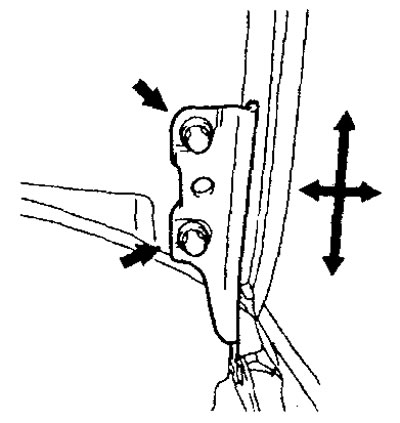
2. Adjust the hood height by turning the hood rubber mounts.

3. Loosen the hood lock mounting bolts and, moving the hood lock, adjust the relative position of the lock and the hood latch.

Fuel filler flap adjustment Loosen the fuel filler cap fixing screws and adjust the filler flap position so that the gap between the filler flap and the body is the same around the entire perimeter of the flap.

Front and rear side door adjustment
1. If the gap around the perimeter between the side door and the body is uneven, then stick a protective tape on the body around the hinge and on the edge of the door, then use a special tool to loosen the bolts securing the door hinge to the body. When moving the door, adjust the gap between the door and the body so that the gap is the same around the entire perimeter of the door.
Caution: Do not apply more than 98 N to the special tool.

For front right door.
2. If the closed door is not flush with the surface of the body, use the special tool to loosen the hinge bolts on the door and adjust the position of the door so that its surface is flush with the surface of the body.

3. If the opening and closing of the door is difficult, then adjust the engagement of the lock and the door latch by installing additional gaskets between the latch and the body pillar and moving the latch either up and down or left and right.
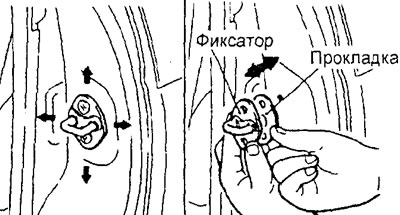
Trunk lid adjustment (sedan)
Loosen the bolts securing the latch and trunk lid and adjust the engagement of the lock and latch of the trunk lid lock and the gap between the trunk lid and the body.

Rear door adjustment (station wagon)
1. If it is difficult to open and close the door, then adjust the engagement of the lock and the door lock latch by moving the lock latch either up and down or left and right.
2. If the gap around the perimeter between the rear door and the body is uneven, then loosen the bolts securing the door hinges and the lock retainer and adjust the gap by moving the hinges or changing the number of shims (total thickness).
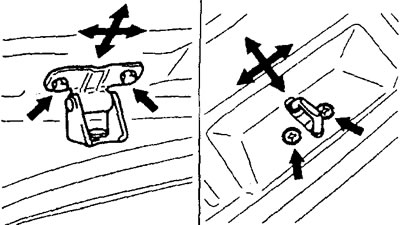
Side door glass adjustment
Check the smoothness of movement of the side door glass along the glass guide when raising and lowering the glass to the extreme positions. If the side door glass does not move up and down smoothly, adjust as follows:
1. Remove the side door trim and waterproof film.
2. Raise the glass of the side door to the extreme position, then loosen the bolts securing the glass to the holder on the power window through the service holes and adjust the position of the glass in the vertical direction.

3. After completing the adjustment, securely tighten the bolts securing the glass to the holder.
Adjustment in the event of a malfunction of the power window of the side door
Note: This adjustment is made if the side door glass automatically starts to move down when the switch is pressed to raise the glass.
1. Remove the side door trim and waterproof film.
2. Lower glass of a lateral door to extreme position, then disconnect glass from the holder on a window regulator. Raise and lower the side door glass by hand to check the operating force.
Attention: install a soft buffer inside the side door to prevent damage to the glass if it is accidentally dropped.

3. If the glass of the side door does not move up and down smoothly, then check the following and, if necessary, repair the parts:
- A) Check that the side door glass seal is installed correctly.
- b) Eliminate kinks in the upper side door glass guide.
- V) Check that the front side door lower glass guide or the rear side door center glass guide is installed correctly.
Note: The lower side door glass guide is not adjustable, but can be moved outwards when reinstalled, within factory tolerances.
4. If repair or adjustment cannot be made, replace the side door assembly.
Checking the operation of the power window safety mechanism
1. Place a piece of wood about 10mm thick as shown in the figure, then lift up the glass of the side door.
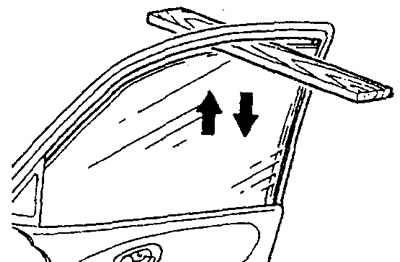
2. Check that after clamping the bar, the glass has lowered by about 150 mm. If the power window operation is not as specified, then the cause may be a malfunction of the power window limit switch, a defective connector or wiring harness, a malfunction of the auxiliary power window switch or the main power window switch, or incorrect adjustment of the limit switch.
Checking the travel of the inside handle for opening the side door
1. Check the match of the move "A" internal handle for opening the side door to the nominal value.
Rated value (IN):
- Front side doors - 9.6±9.2 mm
- Rear side doors - 9.0±9.2 mm

2. If the stroke of the outer handle for opening the side door does not correspond to the nominal value, then remove the trim of the side door and adjust the stroke of the handle by changing the relative position of the latches and the rod of the inner handle for opening the side door.
Checking the stroke of the outside handle of the side door
1. Check the match of the move "IN" the outside handle of the side door to the nominal value.
Rated value (A):
- Front side doors - 2.3±2.1 mm
- Rear side doors - 1.3±1.7 mm

2. If the travel of the outer side door handle is out of specification, check and, if necessary, replace the outer side door handle or side door lock assembly.
Checking the stroke of the outer handle of the rear door (station wagon)
1. Check the match of the move "WITH" outside rear door handle nominal value.
Rated value (IN) - 2.3- 5.9 mm
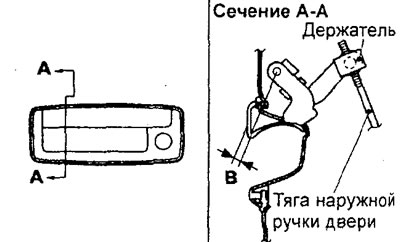
2. If the rear door outside handle travel is not within specification, check the rear door outside handle and rear door lock assembly (adjust the rear door outer handle rod). Replace parts if necessary.
Checking the current in the power window circuit
1. Remove the power window fuse and connect the tester as shown.

2. When the power window switch is moved to the "UP" (up) the maximum current appears in the period of time between the beginning of the glass lifting and its extreme position (glass is fully up). Therefore, the current measurement should be carried out in the range between these two positions.
Rated value - 5±1 A (at a temperature of 25°C and a voltage of 14.5±0.5 V)
3. If the load (current strength) out of specification, the cause may be a power window switch failure, a power window switch failure, a defective connector or wiring harness.
Checking the central lock
1. Check that when you unlock/lock the front side door € with the key or the driver's door with the inside lock button, all doors will automatically unlock/lock.
2. Check that the driver's door will open with the inside side door release handle when all doors are locked. Also check that the locks of all doors, including the trunk lid (sedan) or back door (station wagon), are unlocked at the same time. If not, replace the driver's door lock assembly.
3. Check that the driver's door will not lock if the side door lock button is pressed while the driver's door is open. If the driver's door locks, replace the door lock.
Checking the thermal fuse (power window built into the electric motor)
1. Move the power window switch to the "UP" (up), fully raise the window and continue to hold the switch in this position for 10 seconds (when triggered, the thermal fuse makes a characteristic click).
2. Release the switch and immediately move it to the position "DOWN" (down). The thermal fuse is good if the glass starts to move down within 60 seconds.
Checking the tightness of the hatch
1. Fully close the sunroof glass.
2. Adjust the water pressure so that a jet of water rises from a vertical hose to a height of approximately 50 cm.
3. Position the hose approximately 30 cm above the vehicle roof and spray the sunroof seal with a stream of water for 5 minutes or more.

4. Check that there is no water leaking into the car interior through the sunroof seals.
5. If a leak is found, check the sunroof seals, drain hose, and other sunroof parts.
Sunroof adjustment
1. Fully close the sunroof glass and fully open the sunroof blind.
2. Loosen the screws securing the sunroof assembly, and by moving the sunroof cover, adjust its position so that the glass of the sunroof cover at the front is 1 mm below the roof surface, and at the rear is 1 mm above the roof surface.

3. Securely tighten the screws that secure the sunroof cover assembly.
4. After finishing the adjustments, check the smooth operation of the sunroof electric drive.
Checking the sunroof power off delay function after power off The sunroof operates when the ignition key is set to "ON" or within 30 seconds after turning off the ignition. If any door is opened or the sunroof is fully closed within 30 seconds after the ignition is turned off, the sunroof will stop working until the ignition is turned on.
Checking the operation of the sunroof safety mechanism
1. Place a piece of wood about 10mm thick on the right corner of the sunroof glass, then close the sunroof.
2. Check that after clamping the bar, the sunroof glass returns to its original position.
Load test (current strength) sunroof glass drive
1. Remove the sunroof power circuit fuse and connect the tester as shown.
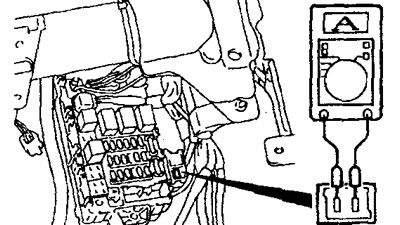
2. Press the switch to the position "ON" and measure the load (current strength), when the sunroof glass moves. Do not take measurements when the sunroof glass is in the extreme tilt position or when the sunroof glass is fully closed or when the sunroof glass is fully open.
Rated value - 7 A or less (at 20°C)
